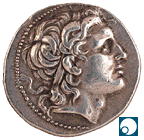

Although some cities managed to remain independent in the Hellenistic
period, the Hellenistic world was above all characterized by kingdoms, first
the immense empire of Alexander the Great, and after his death the smaller
kingdoms carved out of it by his closest associates, the Diadochs or Successors.
Out of the political concerns of these kings came the single most important
development in Hellenistic coinage, the appearance of the ruler portrait
on the obverse of many of their coins, providing us with our first relatively
realistic look at the historical figures of the ancient world. The portraits
are masterpieces of Hellenistic art, depicting in fine detail not only the
features of the men (and occasionally women) about whom we often know so
little, but also indications of how their subjects were intended to regard
them.
The Hellenistic practice of using portraits on coins was in sharp contrast
to Greek custom, which primarily used deities, heroes, and their attributes
as coin types. Ruler portraits had in fact appeared earlier in the East,
in Lycia and in Persia, where as early as the late fifth century B.C. coins
of some local dynasts and provincial governors bore relatively realistic-looking
heads identified by inscription, and these may have influenced the later
kings of the area, but the primary inspiration for the coin portraits of
Hellenistic kings were the portraits of Alexander the Great. Alexander III
(356-323 B.C.), who became king of Macedon in 336 B.C. and who by the time
of his death in 323 B.C. had conquered much of the world known to the West,
followed the example of his father Philip and depicted Greek deities and
heroes on his coins. His coins depicting the hero Herakles, from whom the
Macedonian royal family claimed descent, are particularly significant in
the development of the Hellenistic coin portrait. The head of Herakles appeared
on Alexander's bronze and silver coins, the most important of which were
his tetradrachms (no. 41), which soon
eclipsed Athenian tetradrachms (no. 30)
as the most widely circulated and authoritative coins in the ancient world.
Although there is no evidence to suggest that Alexander regarded these images
as portraits of himself, it appears likely that in parts of his empire where
he had acquired the status of a hero or even a god and where his achievements
were equated with those of his patron hero, the image was widely regarded
as an image of the king himself. And after Alexander's death, the Successors
continued to issue the coins without changes of type, undoubtedly because
the prestige of the coins was so great and because the use of Alexander's
types strengthened their claims to be the legitimate heirs of his kingdom.
(Continues...)



The coin depicted above is No. 45
in the catalogue, tetradrachm of Lysimachos of Thrace, c. 297-81 B.C. Obverse:
Head of Alexander the Great with the hours of Ammon.
All contents copyright (c) 1996.
Lawrence University
All rights reserved.